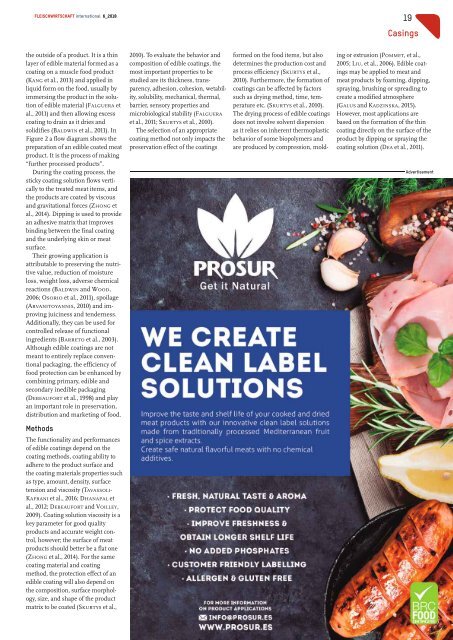FLEISCHWIRTSCHAFT international 6/2018
You also want an ePaper? Increase the reach of your titles
YUMPU automatically turns print PDFs into web optimized ePapers that Google loves.
Fleischwirtschaft <strong>international</strong> 6_<strong>2018</strong><br />
19<br />
Casings<br />
the outside of aproduct. It is athin<br />
layer of edible material formed as a<br />
coating on amuscle food product<br />
(KANG et al., 2013)and applied in<br />
liquid form on the food, usually by<br />
immersing the product in the solution<br />
of edible material (FALGUERA et<br />
al., 2011)and then allowing excess<br />
coating to drain as it dries and<br />
solidifies (BALDWIN et al., 2011). In<br />
Figure 2aflow diagram shows the<br />
preparation of an edible coated meat<br />
product. It is the process of making<br />
“further processed products”.<br />
During the coating process, the<br />
sticky coating solution flows vertically<br />
to the treated meat items, and<br />
the products are coated by viscous<br />
and gravitational forces (ZHONG et<br />
al., 2014). Dipping is used to provide<br />
an adhesive matrix that improves<br />
binding between the final coating<br />
and the underlying skin or meat<br />
surface.<br />
Their growing application is<br />
attributable to preserving the nutritive<br />
value, reduction of moisture<br />
loss, weight loss, adverse chemical<br />
reactions (BALDWIN and WOOD,<br />
2006; OSORIO et al., 2011), spoilage<br />
(ARVANITOYANNIS,2010)and improving<br />
juiciness and tenderness.<br />
Additionally,they can be used for<br />
controlled release of functional<br />
ingredients (BARRETO et al., 2003).<br />
Although edible coatings are not<br />
meant to entirely replace conventional<br />
packaging, the efficiency of<br />
food protection can be enhanced by<br />
combining primary,edible and<br />
secondary inedible packaging<br />
(DEBEAUFORT et al., 1998) and play<br />
an important role in preservation,<br />
distribution and marketing of food.<br />
2010). To evaluate the behavior and<br />
composition of edible coatings, the<br />
most important properties to be<br />
studied are its thickness, transparency,adhesion,<br />
cohesion, wetability,solubility,mechanical,<br />
thermal,<br />
barrier,sensory properties and<br />
microbiological stability (FALGUERA<br />
et al., 2011;SKURTYS et al., 2010).<br />
The selection of an appropriate<br />
coating method not only impacts the<br />
preservation effect of the coatings<br />
formed on the food items, but also<br />
determines the production cost and<br />
process efficiency (SKURTYS et al.,<br />
2010). Furthermore, the formation of<br />
coatings can be affected by factors<br />
such as drying method, time, temperature<br />
etc. (SKURTYS et al., 2010).<br />
The drying process of edible coatings<br />
does not involve solvent dispersion<br />
as it relies on inherent thermoplastic<br />
behavior of some biopolymers and<br />
are produced by compression, molding<br />
or extrusion (POMMET,etal.,<br />
2005; LIU,etal., 2006). Edible coatings<br />
may be applied to meat and<br />
meat products by foaming, dipping,<br />
spraying, brushing or spreading to<br />
create amodified atmosphere<br />
(GALUS and KADZINSKA,2015).<br />
However,most applications are<br />
based on the formation of the thin<br />
coating directly on the surface of the<br />
product by dipping or spraying the<br />
coating solution (DEA et al., 2011).<br />
Advertisement<br />
Methods<br />
The functionality and performances<br />
of edible coatings depend on the<br />
coating methods, coating ability to<br />
adhere to the product surface and<br />
the coating materials properties such<br />
as type, amount, density,surface<br />
tension and viscosity (TAVASSOLI-<br />
KAFRANI et al., 2016;DHANAPAL et<br />
al., 2012;DEBEAUFORT and VOILLEY,<br />
2009). Coating solution viscosity is a<br />
key parameter for good quality<br />
products and accurate weight control,<br />
however;the surface of meat<br />
products should better be aflat one<br />
(ZHONG et al., 2014). Forthe same<br />
coating material and coating<br />
method, the protection effect of an<br />
edible coating will also depend on<br />
the composition, surface morphology,size,<br />
and shape of the product<br />
matrix to be coated (SKURTYS et al.,

















